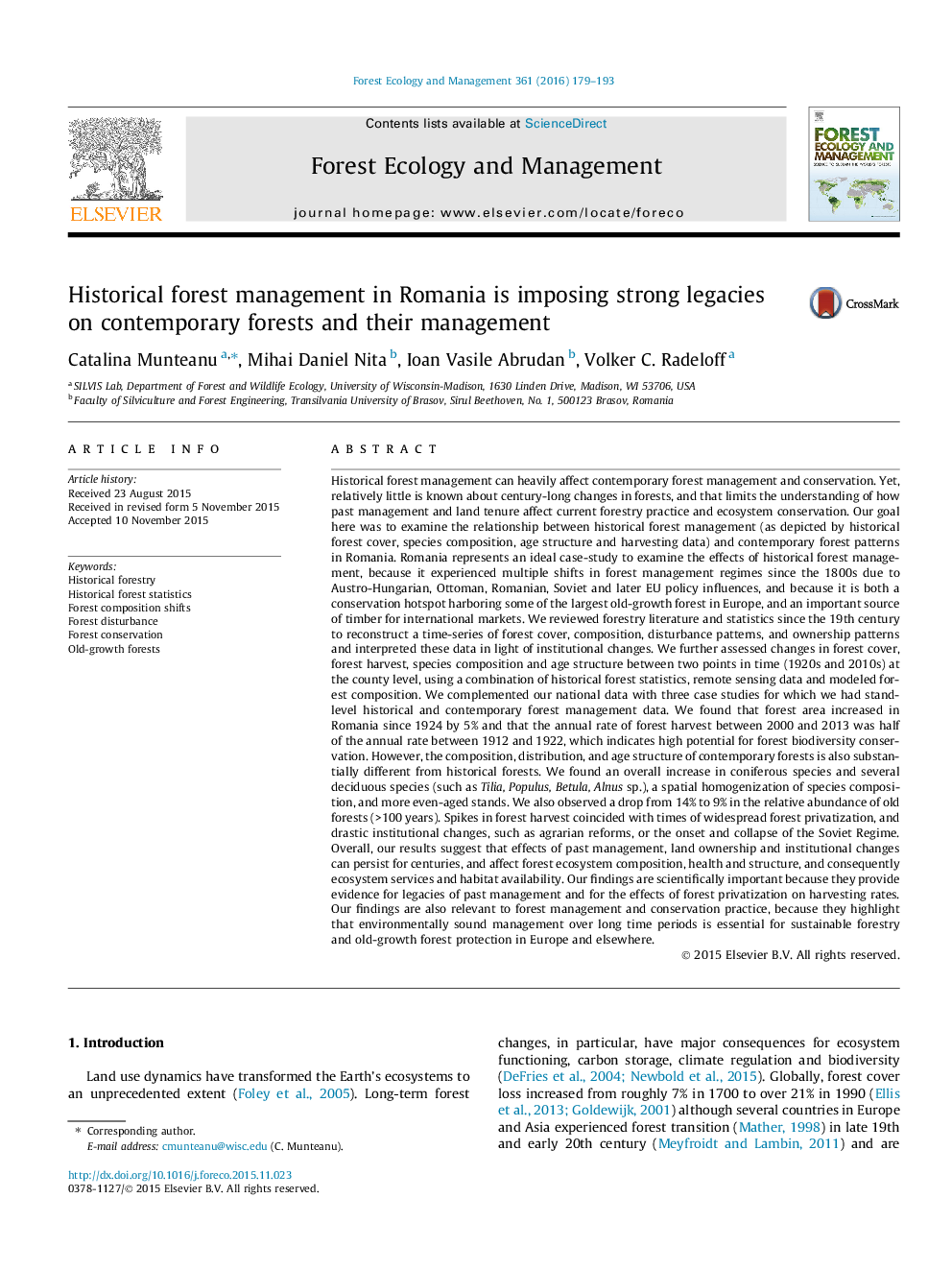| کد مقاله | کد نشریه | سال انتشار | مقاله انگلیسی | نسخه تمام متن |
|---|---|---|---|---|
| 6542448 | 159160 | 2016 | 15 صفحه PDF | دانلود رایگان |
عنوان انگلیسی مقاله ISI
Historical forest management in Romania is imposing strong legacies on contemporary forests and their management
ترجمه فارسی عنوان
مدیریت جنگل های تاریخی در رومانی قرار دادن بقایای قوی در جنگل های معاصر و مدیریت آنها است
دانلود مقاله + سفارش ترجمه
دانلود مقاله ISI انگلیسی
رایگان برای ایرانیان
کلمات کلیدی
جنگل تاریخی، آمار جنگل تاریخی، ترکیب جنگل تغییر می کند، اختلال جنگل، حفاظت از جنگل، جنگل های قدیمی رشد،
موضوعات مرتبط
علوم زیستی و بیوفناوری
علوم کشاورزی و بیولوژیک
بوم شناسی، تکامل، رفتار و سامانه شناسی
چکیده انگلیسی
Historical forest management can heavily affect contemporary forest management and conservation. Yet, relatively little is known about century-long changes in forests, and that limits the understanding of how past management and land tenure affect current forestry practice and ecosystem conservation. Our goal here was to examine the relationship between historical forest management (as depicted by historical forest cover, species composition, age structure and harvesting data) and contemporary forest patterns in Romania. Romania represents an ideal case-study to examine the effects of historical forest management, because it experienced multiple shifts in forest management regimes since the 1800s due to Austro-Hungarian, Ottoman, Romanian, Soviet and later EU policy influences, and because it is both a conservation hotspot harboring some of the largest old-growth forest in Europe, and an important source of timber for international markets. We reviewed forestry literature and statistics since the 19th century to reconstruct a time-series of forest cover, composition, disturbance patterns, and ownership patterns and interpreted these data in light of institutional changes. We further assessed changes in forest cover, forest harvest, species composition and age structure between two points in time (1920s and 2010s) at the county level, using a combination of historical forest statistics, remote sensing data and modeled forest composition. We complemented our national data with three case studies for which we had stand-level historical and contemporary forest management data. We found that forest area increased in Romania since 1924 by 5% and that the annual rate of forest harvest between 2000 and 2013 was half of the annual rate between 1912 and 1922, which indicates high potential for forest biodiversity conservation. However, the composition, distribution, and age structure of contemporary forests is also substantially different from historical forests. We found an overall increase in coniferous species and several deciduous species (such as Tilia, Populus, Betula, Alnus sp.), a spatial homogenization of species composition, and more even-aged stands. We also observed a drop from 14% to 9% in the relative abundance of old forests (>100Â years). Spikes in forest harvest coincided with times of widespread forest privatization, and drastic institutional changes, such as agrarian reforms, or the onset and collapse of the Soviet Regime. Overall, our results suggest that effects of past management, land ownership and institutional changes can persist for centuries, and affect forest ecosystem composition, health and structure, and consequently ecosystem services and habitat availability. Our findings are scientifically important because they provide evidence for legacies of past management and for the effects of forest privatization on harvesting rates. Our findings are also relevant to forest management and conservation practice, because they highlight that environmentally sound management over long time periods is essential for sustainable forestry and old-growth forest protection in Europe and elsewhere.
ناشر
Database: Elsevier - ScienceDirect (ساینس دایرکت)
Journal: Forest Ecology and Management - Volume 361, 1 February 2016, Pages 179-193
Journal: Forest Ecology and Management - Volume 361, 1 February 2016, Pages 179-193
نویسندگان
Catalina Munteanu, Mihai Daniel Nita, Ioan Vasile Abrudan, Volker C. Radeloff,
